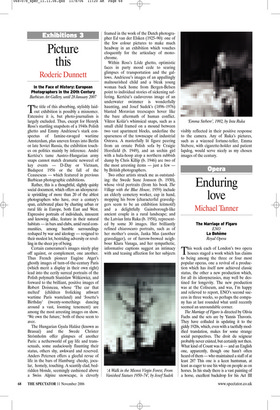Picture this
Roderic Dunnett
In the Face of History: European Photographers in the 20th Century Barbican Art Gallery, until 28 January 2007 The title of this absorbing, stylishly laidout exhibition is possibly a misnomer. Extensive it is, but photo-journalism is largely excluded. Thus, except for Henryk Ross’s startling snapshots of a 1940s Polish ghetto and Emmy Andriesse’s stark conspectus of famine-ravaged wartime Amsterdam, plus uneven forays into Berlin or late Soviet Russia, the exhibition touches on politics mainly by inference. André Kertész’s tame Austro–Hungarian army snaps cannot match dramatic newsreel of key events — D-Day or Vietnam, Budapest 1956 or the fall of the Ceausescus — which featured in previous Barbican photographic exhibitions.
Rather, this is a thoughtful, slightly quirky social document, which offers an idiosyncratic sprinkling of more than 20 of the ablest photographers who have, over a century’s span, celebrated place by charting urban or rural life in Europe, both East and West. Expressive portraits of individuals, innocent and knowing alike, feature in their natural habitats — in bars and clubs, amid rural communities, among humble surroundings reshaped by war and ideology — resigned to their modest lot, bestriding adversity or revelling in the sheer joy of being.
Certain cameramen’s images nicely play off against, or complement, one another. Thus French pioneer Eugène Atget’s ghostly images of turn-of-the-century Paris (which merit a display in their own right) lead into the eerily surreal portraits of the Polish polymath Stanislaw Witkiewicz, and forward to the brilliant, positive images of Robert Doisneau, whose ‘The car that melted’ (children frolicking athwart wartime Paris wasteland) and ‘Josette’s Birthday’ (twenty-somethings dancing around a vast, looming tenement) are among the most arresting images on show. ‘We own the future,’ both of these seem to aver.
The Hungarian Gyula Halász (known as Brassaï) and the Swede Christer Strömholm offer glimpses of another Paris: a netherworld of gay life and transsexuals, some audaciously flaunting their status, others shy, awkward and reserved. Anders Petersen offers a gleeful revue of life in the bars of Hamburg: cheeky, jocular, homely, touching. A scantily clad, bedridden blonde, seemingly cushioned above a Swiss Alpine snowscape, is cleverly framed in the work of the Dutch photographer Ed van der Elsken (1925–90): one of the few colour pictures to make much headway in an exhibition which vouches eloquently for the articulacy of monochrome.
Within Ross’s Lódz ghetto, optimistic faces in party mood cede to searing glimpses of transportation and the gallows. Andriesse’s images of an appallingly malnourished child and a bleak young woman back home from Bergen-Belsen point to individual stories of sickening suffering. Kertész’s cadaverous image of an underwater swimmer is wonderfully haunting, and Josef Sudek’s (1896–1976) blasted Moravian treescapes hover like the bare aftermath of human conflict. Viktor Kolár’s whimsical snaps, such as a small child framed on a mound between two vast apartment blocks, underline the sparseness of the townscape of industrial Ostrava. A masterfully lit figure peering from an ornate Polish sofa by Craigie Horsfield (b. 1949), and an urchin girl with a hula-hoop atop a northern rubbish dump by Chris Killip (b. 1946) are two of the most arresting items — just a few by British photographers.
Two other artists struck me as outstanding: the Swede Sune Jonsson (b. 1930), whose vivid portraits (from his book The Village with the Blue House, 1959) include an elderly cemetery worker, cap in hand, mopping his brow (characterful gravediggers seem to be an exhibition leitmotif) and a delightfully Gainsborough-like ancient couple in a rural landscape; and the Latvian Inta Ruka (b. 1958), represented by some 30 images. Her brilliantly refined chiaroscuro portraits, such as of her mother’s cousin, Janka Mas (another gravedigger), or of furrow-browed neighbour Klara Vanaga, and her sympathetic, informative captions suggest an intimacy with and teasing affection for her subjects


































































































 Previous page
Previous page